Numerical Investigation and Factorial Analysis of Residual Displacement in Rocking Self-Centering Bridge Columns Under Cyclic Loading
Abstract
1. Introduction
2. Simulation of RSC Columns
2.1. Simulation Method
2.2. Model Validation
3. Governing Design Parameters for Residual Displacement
3.1. Definition and Calculation of SC Factor
- Step 1: Establish the numerical model of the RSC-ED columns and conduct a pushover analysis; then, the force-displacement curve can be obtained. The force FRSC-ED includes the self-centering and energy dissipation contribution.
- Step 2: Delete the ED bar elements from the existing numerical model of the RSC-ED column. The corresponding numerical model of an RSC-NED pier is obtained. Then, perform a pushover analysis again. As a result, a force-displacement curve that only contains the self-centering contribution will be obtained. Therefore, the energy dissipation contribution FED can be derived as:
3.2. Definition and Calculation of ED Parameter
- Step 1: Establish the FE model of an RSC-ED column and perform a pushover analysis. Then, the obtained pushover curve is bilinearized according to the equal energy principle. As a result, the parameter FRSC-ED,y can be determined.
- Step 2: Delete the ED bar elements from the FE model and carry out a pushover analysis again. Then, the force–displacement curve representing the energy dissipation contribution can be plotted by subtraction. Conduct an equivalent linearization again, and the parameter FED,y is obtained.
4. Fractional Factorial Analysis
4.1. Design Parameters of Reference Specimen
4.2. Two-Level Fractional Design
4.3. Results of Factorial Analysis
5. Formula for Predicting Residual Displacement Under Cyclic Loading
5.1. Parametric Study
5.2. Regression Analysis
6. Conclusions
- Simplifying the strain penetration of energy-consuming steel bars to equivalent unbonded segment lengths can lead to an underestimation of self-resetting capacity and residual displacement. Ignoring the strain penetration of ED bars will underestimate the self-centering capacity of RSC columns and conservative residual displacement will be obtained. Therefore, when establishing RSC pier models, it is essential to consider the impact of strain penetration to enhance the accuracy of prediction outcomes.
- The total contribution of the eight parameters to the SC factor and ED parameter is stable and maintained at approximately 84% and 95%, respectively. No significant interaction between these factors is observed. Due to the P−Δeffect, the contribution of the gravity loading ratio to the SC factor will decrease rapidly as the displacement increases, and the effect of the aspect ratio will grow.
- The SC factor, ED parameter, and maximum displacement dominate the distribution of residual displacement under cyclic loading. When the SC factor exceeds 2.0 or the ED parameter is smaller than 0.75, the residual displacement can be neglected. In other situations, the residual displacement can be estimated using the upper limit formula and the regression formula. This implies that, during the design of RSC piers, controlling residual displacement can be achieved by adjusting the rocking self-resetting factor and energy dissipation capacity parameters.
- The unbonded length of ED bars has little influence on the SC factor and the ED parameter. However, if the unbonded length is too long, the residual displacement can effectively be diminished because of the changed unloading path. This means that, when designing RSC piers, the length of unbonded energy-dissipating steel rods can be adjusted as needed to achieve the desired self-resetting capacity, energy-dissipating capacity, and residual displacement control effect.
Author Contributions
Funding
Data Availability Statement
Conflicts of Interest
Abbreviations
| RC | Reinforced concrete |
| RSC | Rocking self-centering |
| SC | Self-centering |
| ED | Energy dissipation |
References
- Han, Q.; Du, X.; Liu, J. Seismic damage of highway bridges during the 2008 Wenchuan earthquake. Earthq. Eng. Eng. Vib. 2009, 8, 263–273. [Google Scholar] [CrossRef]
- Shi, Y.; Zhong, Z.; Qin, H.; Sun, Z. Toggle buckling-restrained brace systems and a corresponding design method for the seismic retrofit of bridge bents. Eng. Struct. 2020, 221, 110996. [Google Scholar] [CrossRef]
- Kawashima, K.; Macrae, G.A.; Hoshikuma, J.I.; Nagaya, K. Residual displacement response spectrum. J. Struct. Eng. 1998, 124, 523–530. [Google Scholar] [CrossRef]
- Uma, S.R.; Pampanin, S.; Christopoulos, C. Development of probabilistic framework for performance-based seismic assessment of structures considering residual deformations. J. Earthq. Eng. 2010, 14, 1092–1111. [Google Scholar] [CrossRef]
- Palermo, A.; Mashal, M. Accelerated bridge construction (ABC) and seismic damage resistant technology: A New Zealand challenge. Bull. N. Z. Soc. Earthq. 2012, 45, 123–134. [Google Scholar]
- Marsh, M.L.; Wernli, M.; Garrett, B.E. Application of Accelerated Bridge Construction Connections in Moderate-to-High Seismic Regions, NCHRP Report 698; Transportation Research Board: Washington, DC, USA, 2011. [Google Scholar]
- Zhang, D.; Li, N.; Li, Z.X. Seismic performance of precast segmental concrete-filled steel-tube bridge columns with internal and external energy dissipaters. J. Bridge Eng. 2021, 26, 04021085. [Google Scholar] [CrossRef]
- Hewes, J.T. Seismic Design and Performance of Precast Concrete Segmental Bridge Columns; University of California: San Diego, CA, USA, 2002. [Google Scholar]
- Palermo, A.; Pampanin, S.; Marriott, D. Design modeling, and experimental response of seismic resistant bridge piers with posttensioned dissipating connections. J. Struct. Eng. 2007, 133, 1648–1661. [Google Scholar] [CrossRef]
- Ou, Y.C.; Wang, P.H.; Tsai, M.S.; Chang, K.C.; Lee, G.C. Large-scale experimental study of precast segmental unbonded posttensioned concrete bridge columns for seismic regions. J. Struct. Eng. 2010, 136, 255–264. [Google Scholar] [CrossRef]
- Bu, Z.Y.; Ou, Y.C.; Song, J.W.; Zhang, N.S.; Lee, G.C. Cyclic loading test of unbonded and bonded posttensioned precast segmental bridge columns with circular section. J. Bridge Eng. 2016, 21, 04015043. [Google Scholar] [CrossRef]
- Elgawady, M.A.; Sha’lan, A. Seismic behavior of self-centering precast segmental bridge bents. J. Bridge Eng. 2011, 16, 328–339. [Google Scholar] [CrossRef]
- Guo, T.; Cao, Z.; Xu, Z.; Lu, S. Cyclic load tests on self-centering concrete pier with external dissipators and enhanced durability. J. Struct. Eng. 2015, 142, 04015088. [Google Scholar] [CrossRef]
- Shi, Y.; Zhong, Z.W.; Qin, H.G. Seismic performance and corresponding design method of rocking self-centering bridge bents equipped with lead-extrusion dampers. Eng. Mech. 2021, 38, 166–177, 203. [Google Scholar]
- Han, Q.; Jia, Z.; Xu, K.; Zhou, X.; Du, X. Hysteretic behavior investigation of self-centering double-column rocking piers for seismic resilience. Eng. Struct. 2019, 188, 218–232. [Google Scholar] [CrossRef]
- Tong, T.; Zhuo, W.; Jiang, X.; Lei, H.; Liu, Z. Research on seismic resilience of prestressed precast segmental bridge piers reinforced with high-strength bars through experimental testing and numerical modelling. Eng. Struct. 2019, 197, 10335. [Google Scholar] [CrossRef]
- Cai, Z.K.; Wang, D.; Wang, Z. Full-scale seismic testing of concrete building columns reinforced with both steel and CFRP bars. Compos. Struct. 2017, 178, 195–209. [Google Scholar] [CrossRef]
- Roh, H.; Reinhorn, A.M. Hysteretic behavior of precast segmental bridge piers with superelastic shape memory alloy bars. Eng. Struct. 2010, 32, 3394–3403. [Google Scholar] [CrossRef]
- Shi, Y.; Wang, D.; Qin, H.; Chen, X.; Han, J.; Zhang, Z. Strength reduction factor spectra for SDOF systems with structural fuses. Soil Dyn. Earthq. Eng. 2023, 169, 107895. [Google Scholar] [CrossRef]
- Wu, S.; Li, J.; Chen, X.; Guan, Z. Seismic residual displacement for structural system with partial self-centering ability. J. Bridge Eng. 2024, 95, 110123. [Google Scholar] [CrossRef]
- Guo, J.; Guo, B.; Nie, L.; Sun, R.; Zhao, W. Seismic resilience mechanism of self-centering dual-limb thin-walled rocking piers with replaceable energy dissipation beams. Earthq. Eng. Struct. Dyn. 2024, 53, 1803–1825. [Google Scholar] [CrossRef]
- Japan Road Association. Specifications for Highway Bridges-Part V Seismic Design; Marusan Publishing: Tokyo, Japan, 2002. [Google Scholar]
- Liossatou, E.; Fardis, M.N. Near-fault effects on residual displacements of RC structures. Earthq. Eng. Struct. Dyn. 2016, 45, 1391–1409. [Google Scholar] [CrossRef]
- Cheng, H.; Li, H.; Wang, D.S.; Sun, Z.; Li, G.; Jin, J. Research on the influencing factors for residual displacements of RC bridge columns subjected to earthquake loading. Bull. Earthq. Eng. 2016, 14, 2229–2257. [Google Scholar] [CrossRef]
- Ji, D.; Wen, W.; Zhai, C.; Katsanos, E.I. Residual displacement ratios of SDOF systems subjected to ground motions recorded on soft soils. Soil Dyn. Earthq. Eng. 2018, 115, 331–335. [Google Scholar] [CrossRef]
- Amiri, S.; Bojorquez, E. Residual displacement ratios of structures under mainshock-aftershock sequences. Soil Dyn. Earthq. Eng. 2019, 121, 179–193. [Google Scholar] [CrossRef]
- Zhan, S.; Jian, Z. Dimensional estimation of residual-displacement demands for bilinear bridges under near-fault ground motions. J. Bridge Eng. 2018, 23, 04018087. [Google Scholar]
- Quinde, P.; Teran, A.; Reinoso, E. Residual displacement estimation for soft soils: Application to Mexico city lake-bed. Soil Dyn. Earthq. Eng. 2019, 130, 105970. [Google Scholar] [CrossRef]
- Li, S.; Zhao, T.; Alam, M.S.; Cheng, Z.; Wang, J. Probabilistic seismic vulnerability and loss assessment of a seismic resistance bridge system with post-tensioning precast segmental ultra-high performance concrete bridge columns. Eng. Struct. 2020, 225, 111321. [Google Scholar] [CrossRef]
- Ou, Y.C.; Chiewanichakorn, M.; Aref, A.J.; Lee, G.C. Seismic performance of segmental precast unbonded posttensioned concrete bridge columns. J. Struct. Eng. 2007, 133, 1636–1647. [Google Scholar] [CrossRef]
- Cai, Z.K.; Zhou, Z.; Wang, Z. Influencing factors of residual displacements of precast segmental bridge columns with energy dissipation bars. Adv. Struct. Eng. 2019, 22, 126–140. [Google Scholar] [CrossRef]
- Liu, X.; Li, J.; Tsang, H.H.; Wilson, J.L. Evaluating self-centering behavior of unbonded prestressed bridge columns using a new performance index based on quasi-static analysis. J. Earthq. Tsunami 2018, 12, 1850001. [Google Scholar] [CrossRef]
- Wang, Z.; Wang, J.; Zhao, G.; Zhang, J. Design criterion for the self-centering capacity of precast segmental UHPC bridge columns with unbonded post-tensioning tendons. Eng. Struct. 2019, 200, 109706. [Google Scholar] [CrossRef]
- Tazarv, M.; Hart, K.; Khan, A. Rocking bridge columns with external replaceable tendons. J. Bridge Eng. 2024, 29, 04024008. [Google Scholar] [CrossRef]
- Jia, X.; Dong, H.; Su, C.; Han, Q. Seismic performance of the self-centering rocking columns with SMA L-shaped plates. Structures 2024, 60, 105914. [Google Scholar] [CrossRef]
- Ahmdi, E.; Kashani, M.M. Numerical investigation of nonlinear static and dynamic behaviour of self-centring rocking segmental bridge piers. Soil Dyn. Earthq. Eng. 2020, 128, 105876. [Google Scholar] [CrossRef]
- Marriott, D.; Pampanin, S.; Palermo, A. Quasi-static and pseudo-dynamic testing of unbonded post-tensioned rocking bridge piers with external replaceable dissipaters. Earthq. Eng. Struct. Dyn. 2009, 38, 331–354. [Google Scholar] [CrossRef]
- Priestley, M.J.N.; Calvi, G.M.; Kowalsky, M.J. Displacement-based seismic design of structures. In Earthquake Spectra; IUSS Press: Rome, Italy, 2007. [Google Scholar]
- Kowalsky, M.J.; Priestley, M.J.N.; Macrae, G.A. Displacement-based design of RC bridge columns in seismic regions. Earthq. Eng. Struct. Dyn. 1995, 24, 1623–1643. [Google Scholar] [CrossRef]
- Mantawy, I.M.; Sanders, D.H.; Eberhard, M.O.; Stanton, J.F. Modelling of debonded reinforcement in ABC connections designed for seismic zones. Eng. Struct. 2019, 198, 109351. [Google Scholar] [CrossRef]
- Pampanin, S.; Priestley, M.J.N.; Sritharan, S. Analytical modelling of the seismic behaviour of precast concrete frames designed with ductile connections. J. Earthq. Eng. 2001, 5, 329–367. [Google Scholar] [CrossRef]
- Bu, Z.Y.; Ou, Y.C. Simplified analytical pushover method for precast segmental concrete bridge columns. Adv. Struct. Eng. 2013, 16, 805–822. [Google Scholar] [CrossRef]
- Guo, J.; Xin, K.G.; He, M.H.; Hu, L. Experimental study and analysis on the seismic performance of a self-centering bridge pier. Eng. Mech. 2012, 29, 29–34. [Google Scholar]
- Hieber, D.G.; Wacker, J.M.; Eberhard, M.O.; Stanton, J.F. Precast Concrete Pier Systems for Rapid Construction of Bridges in Seismic Region; University of Washington: Seattle, WA, USA, 2005. [Google Scholar]
- Montgomery, D.C. Design and Analysis of Experiments; John Wiley and Sons: New York, NY, USA, 2008. [Google Scholar]
- Ding, Y.; Shi, Y.; Qin, H.; Wang, X. Strength Reduction Factor of Steel Frames with Stainless-Steel Braces. Buildings 2025, 15, 681. [Google Scholar] [CrossRef]
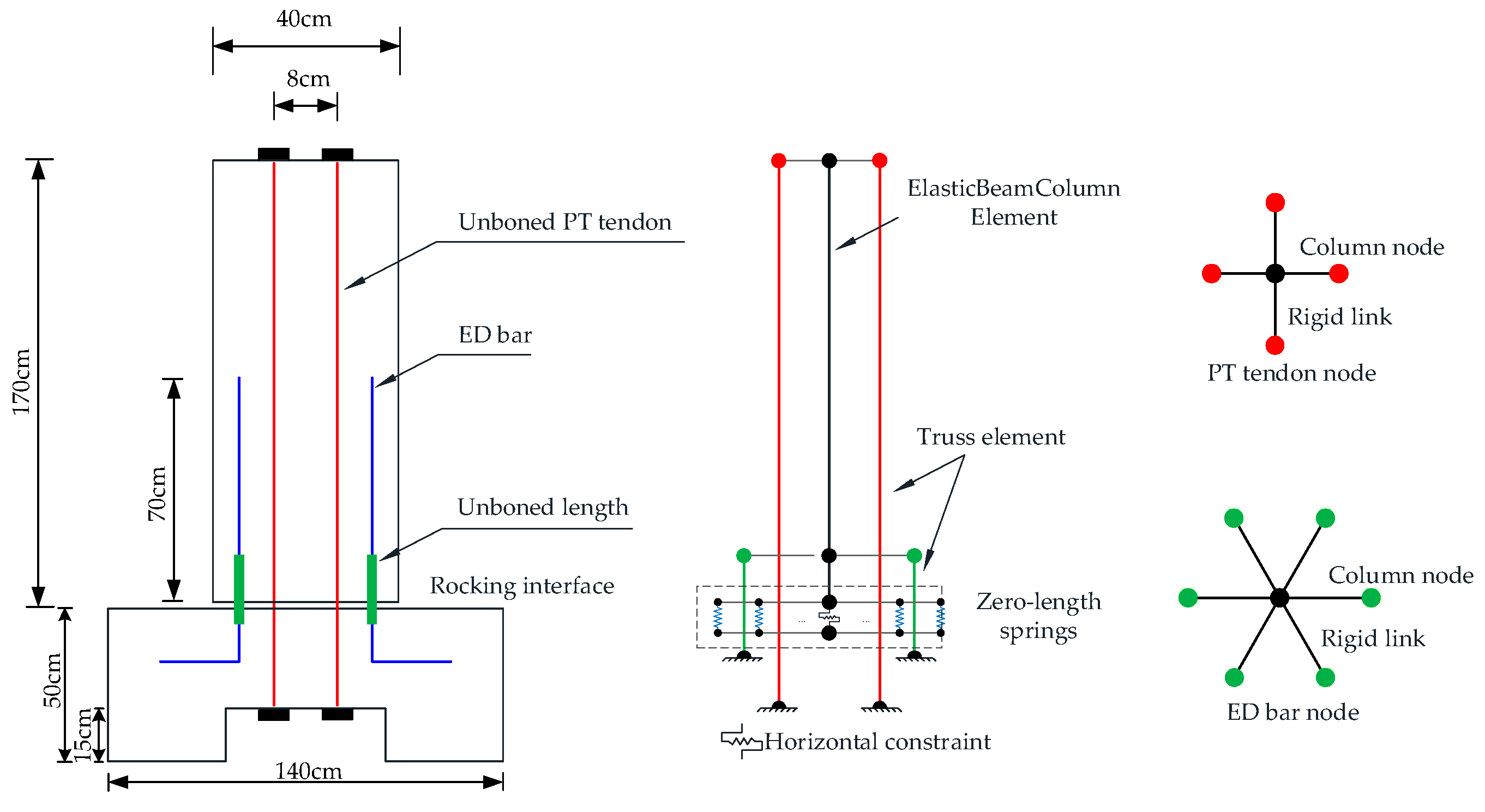
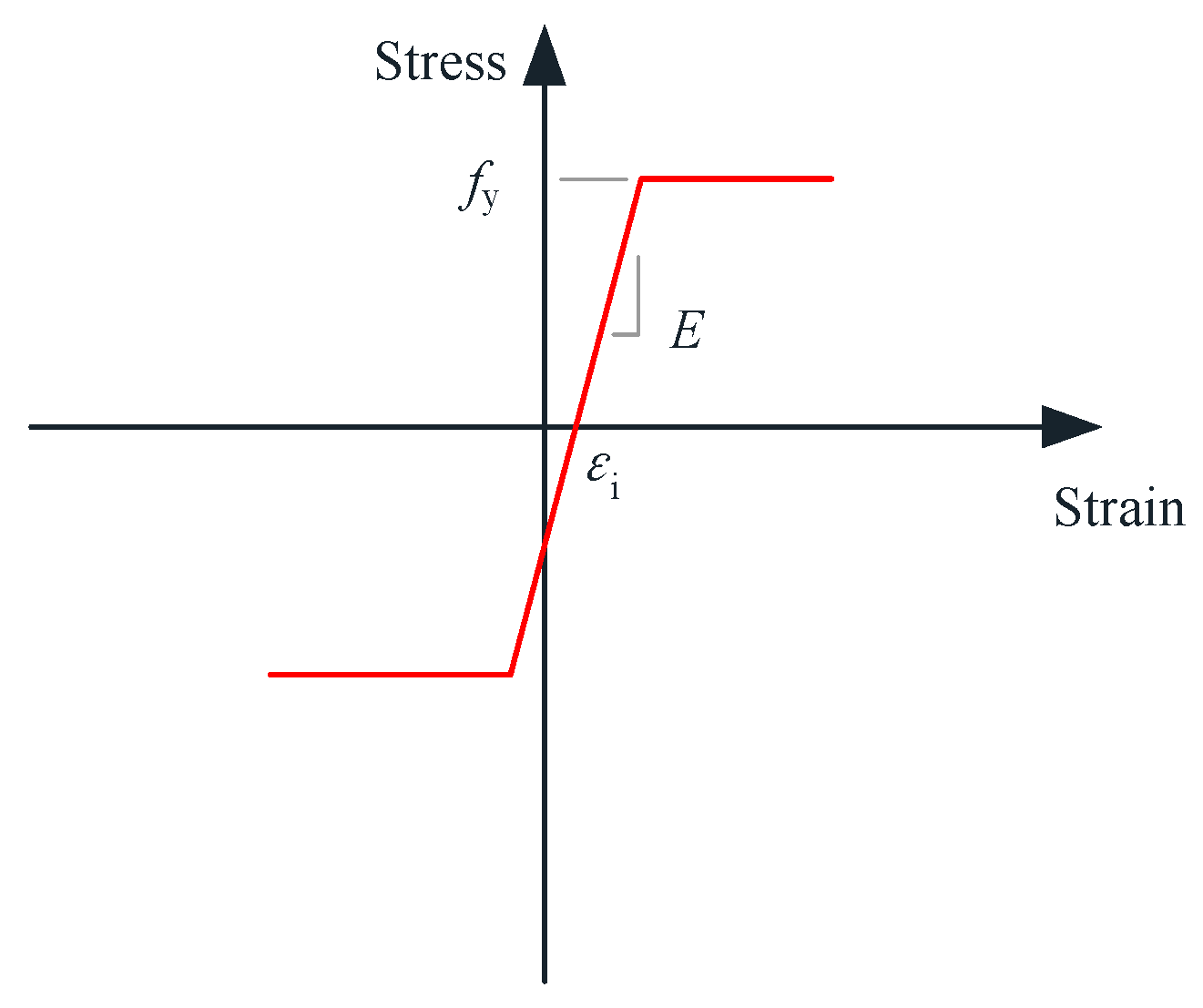
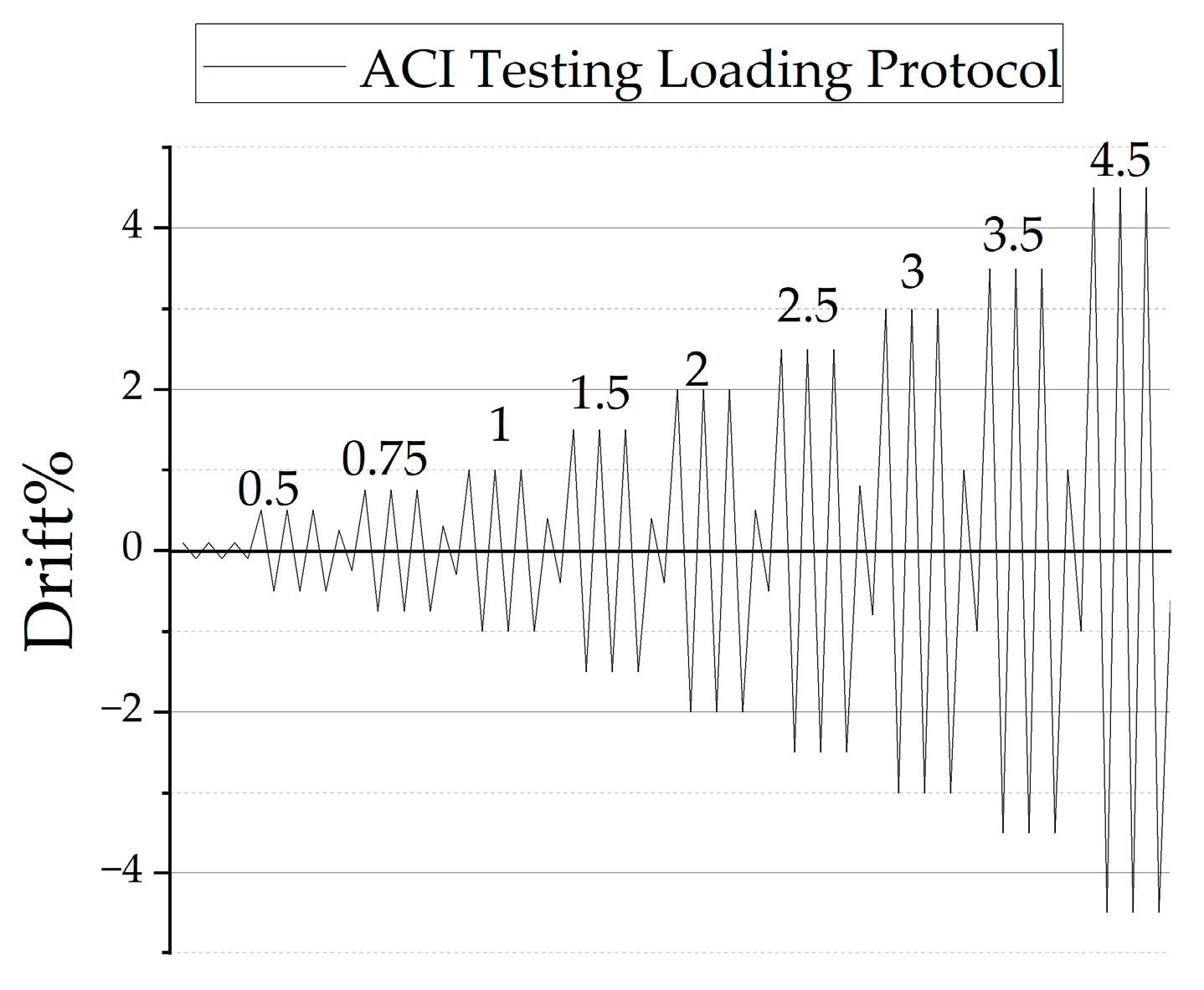
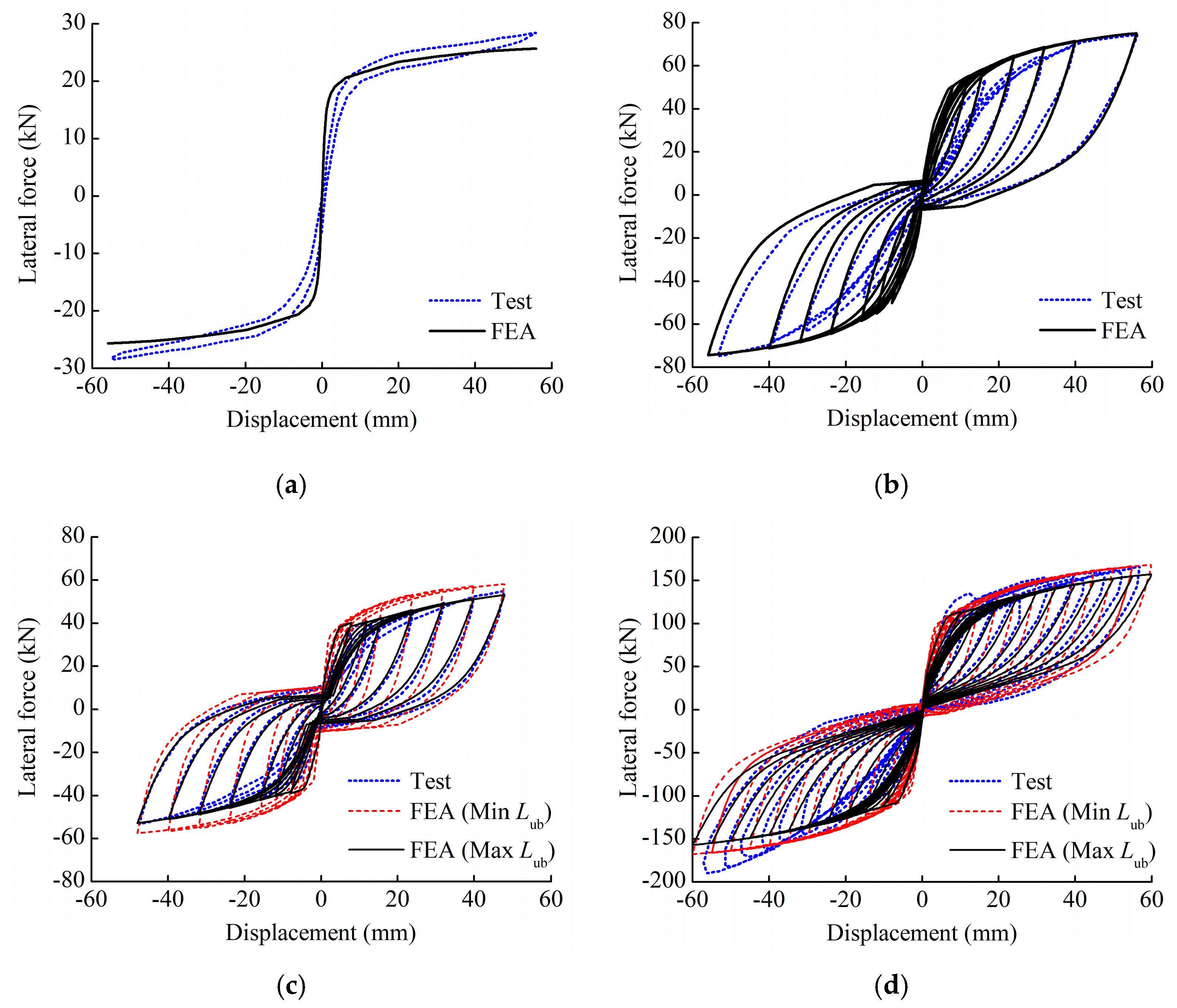
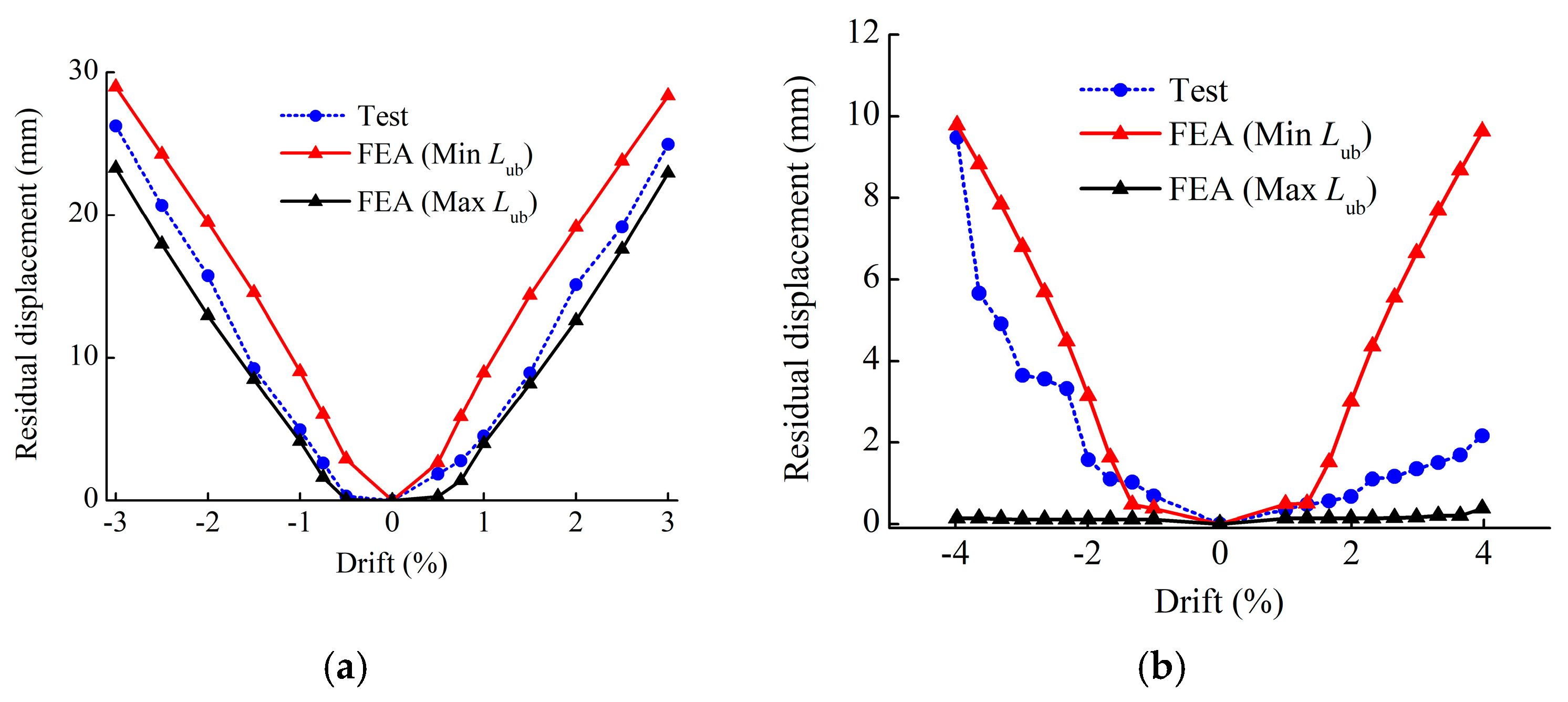
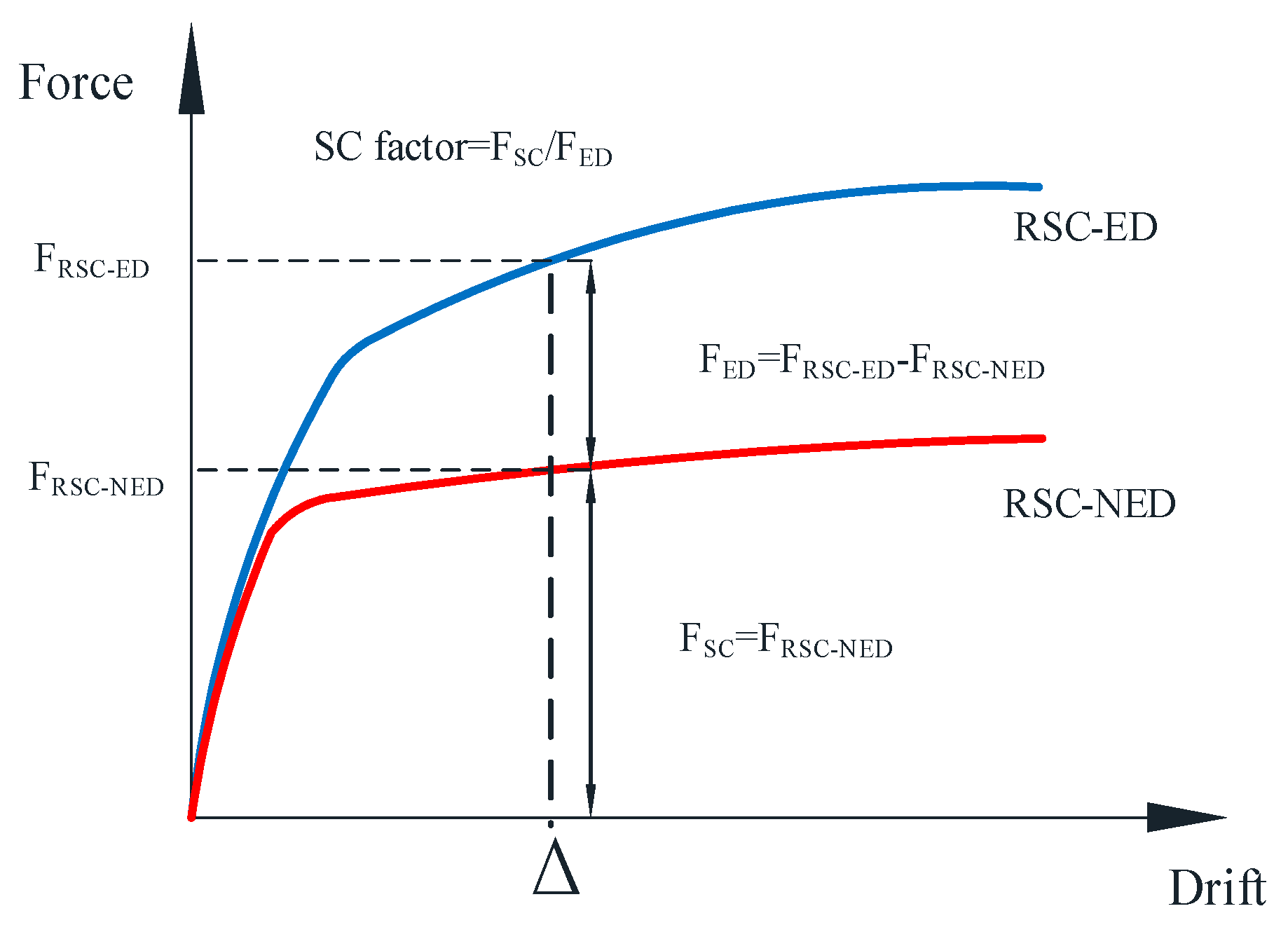
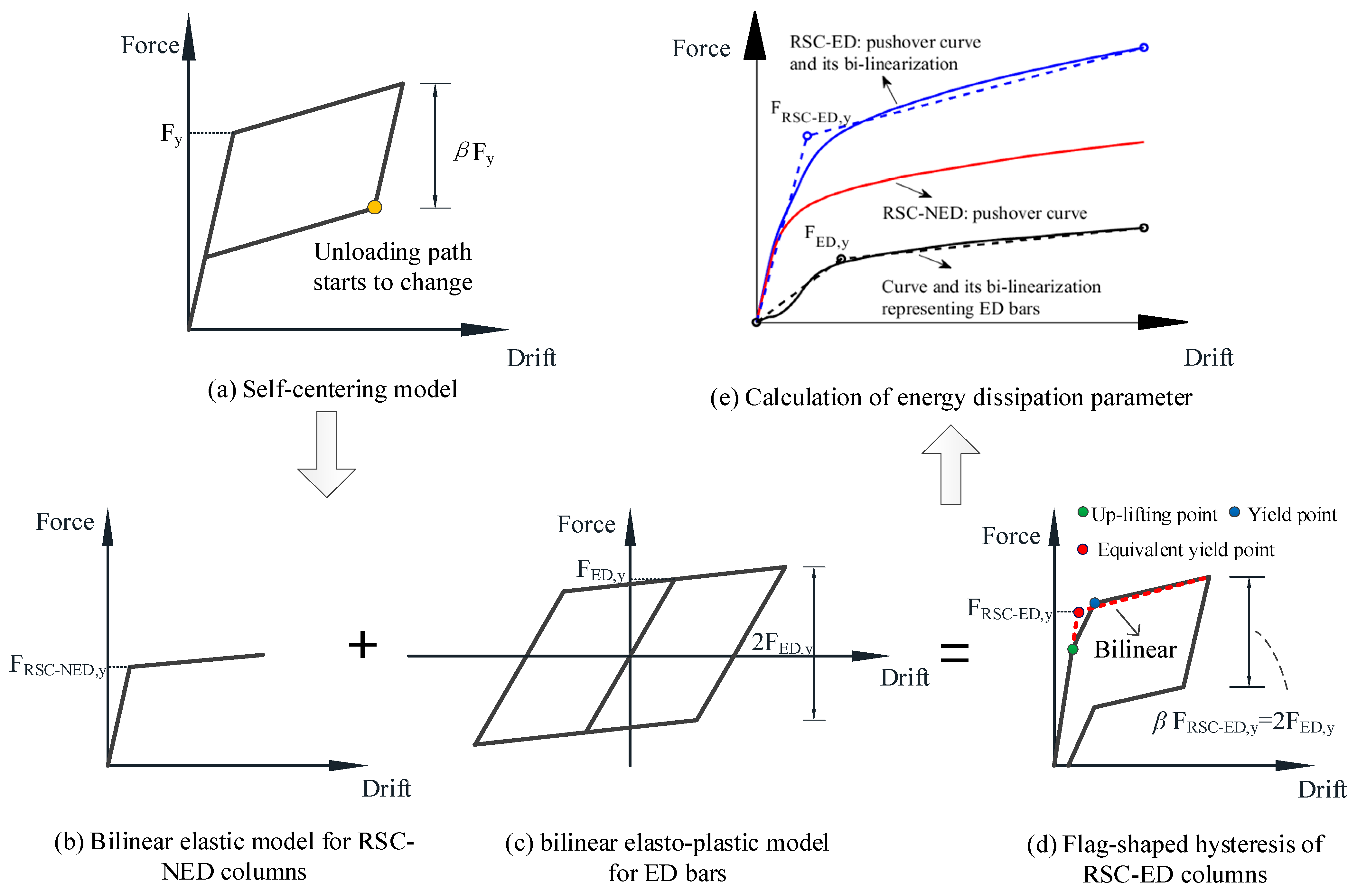






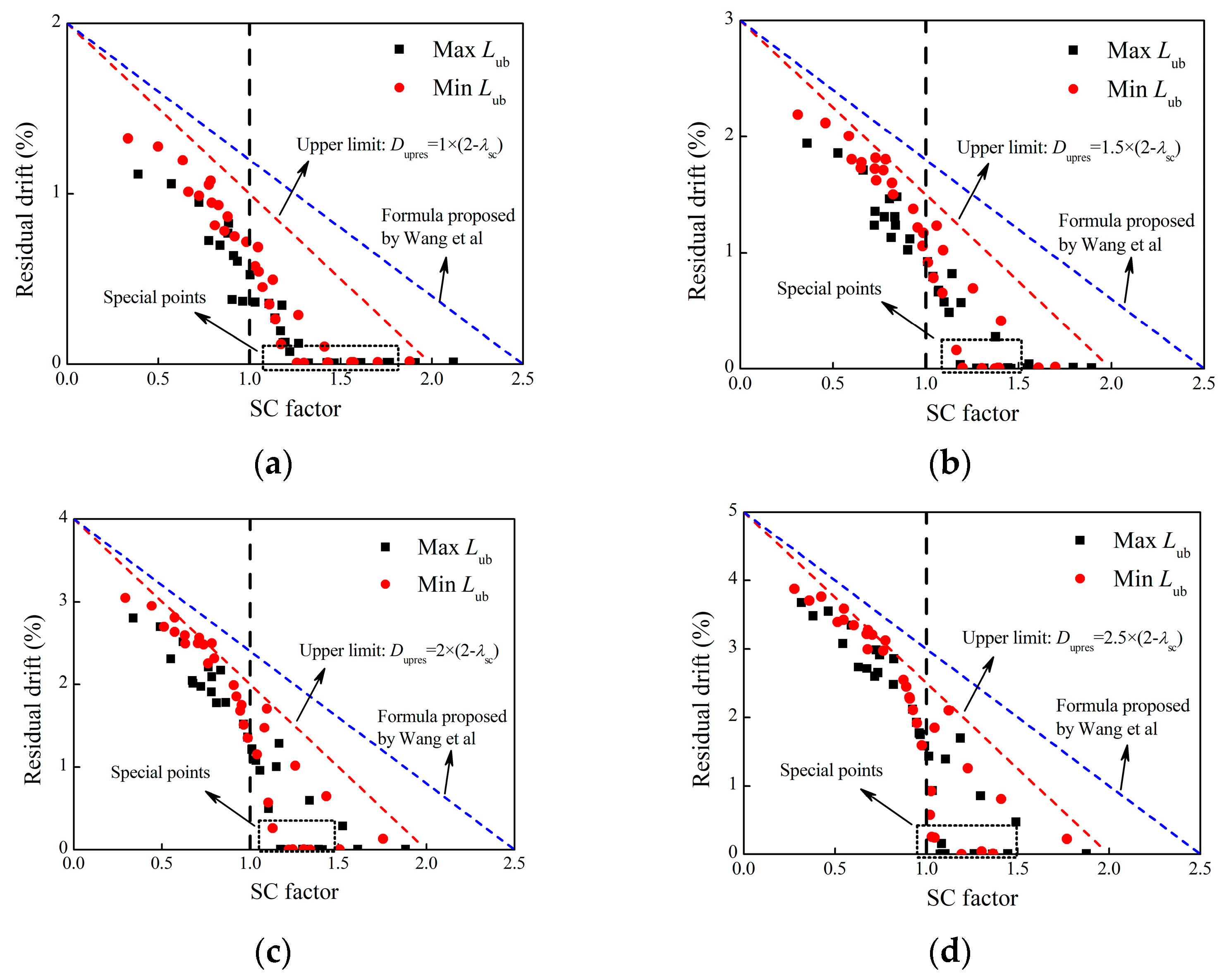
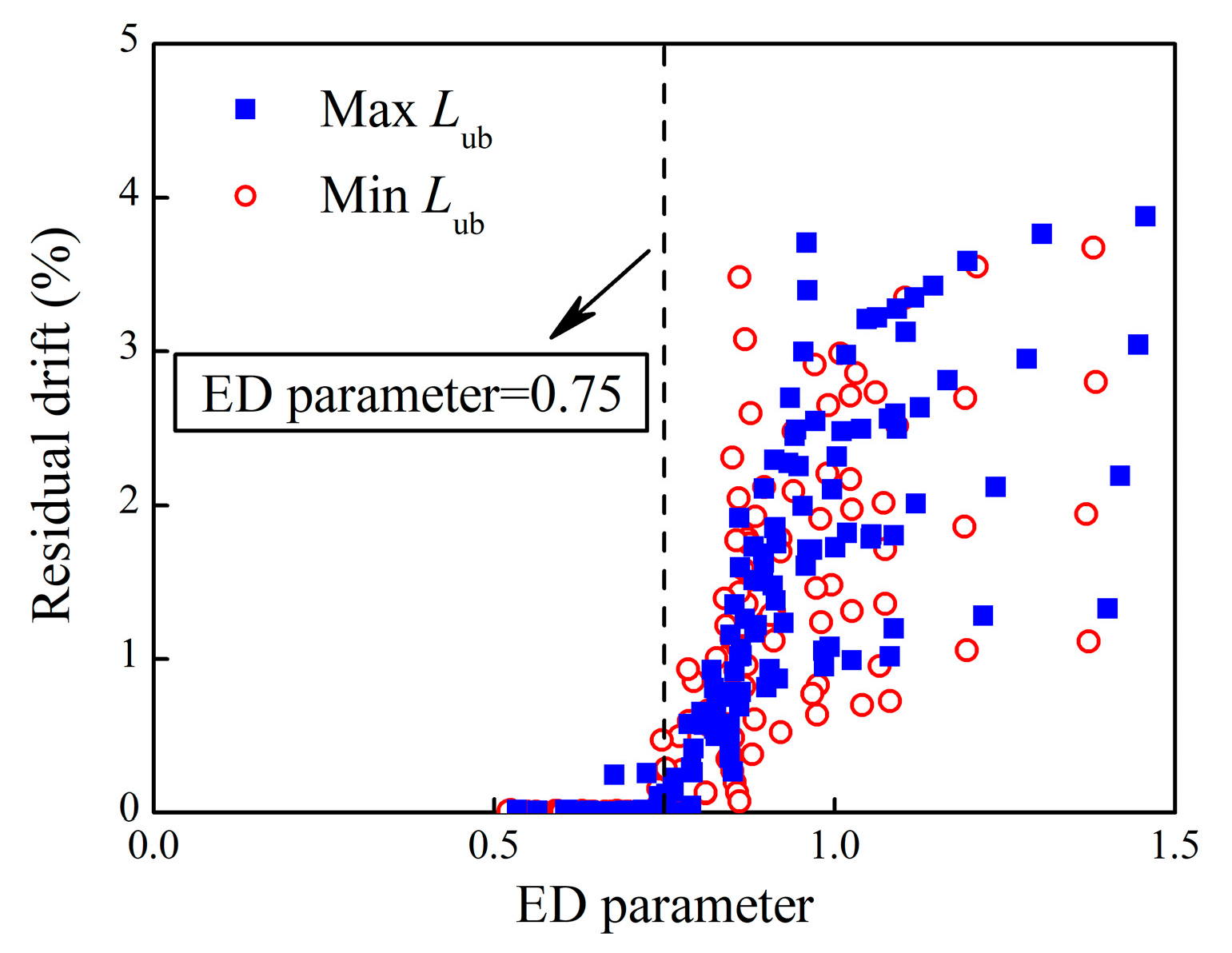
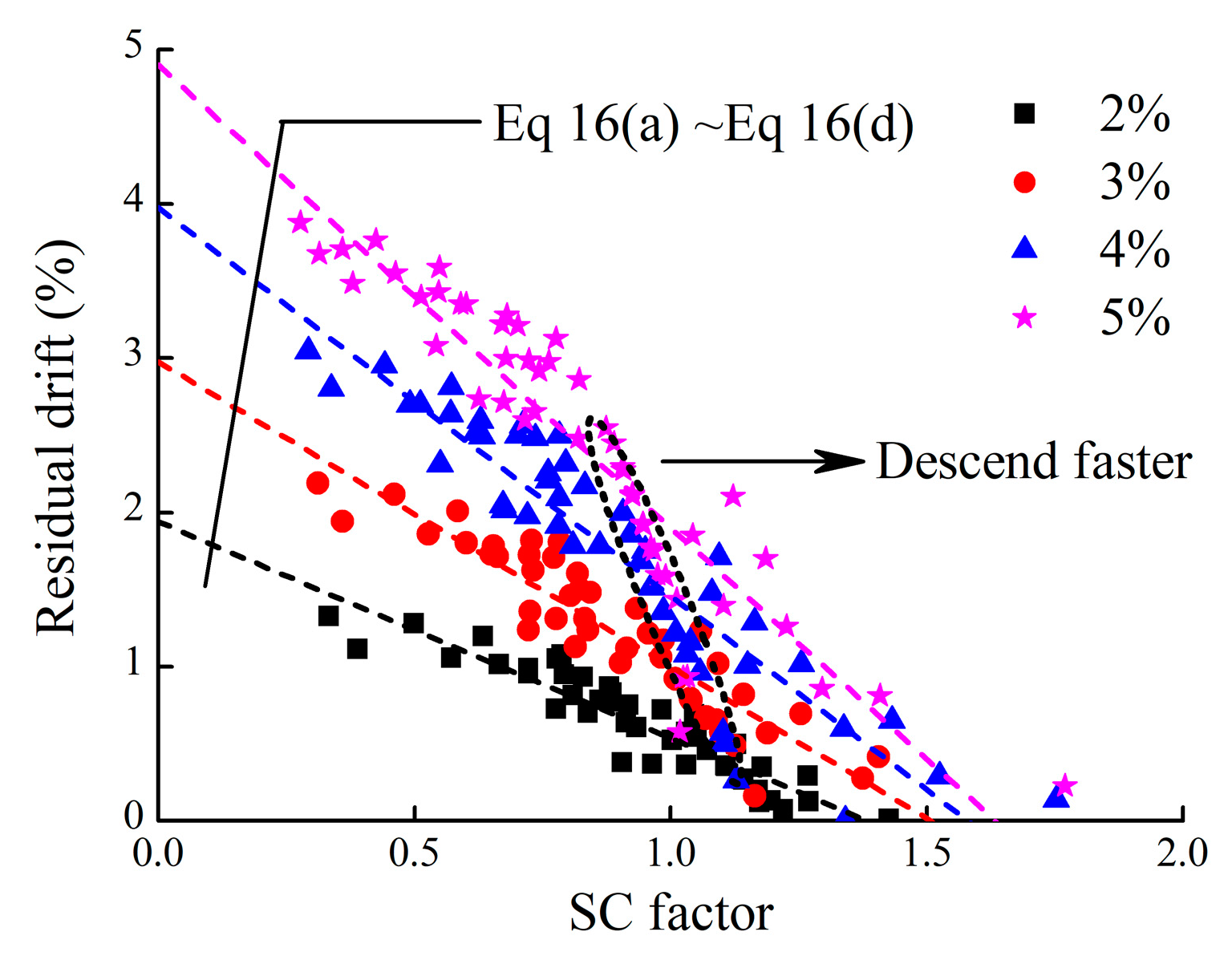
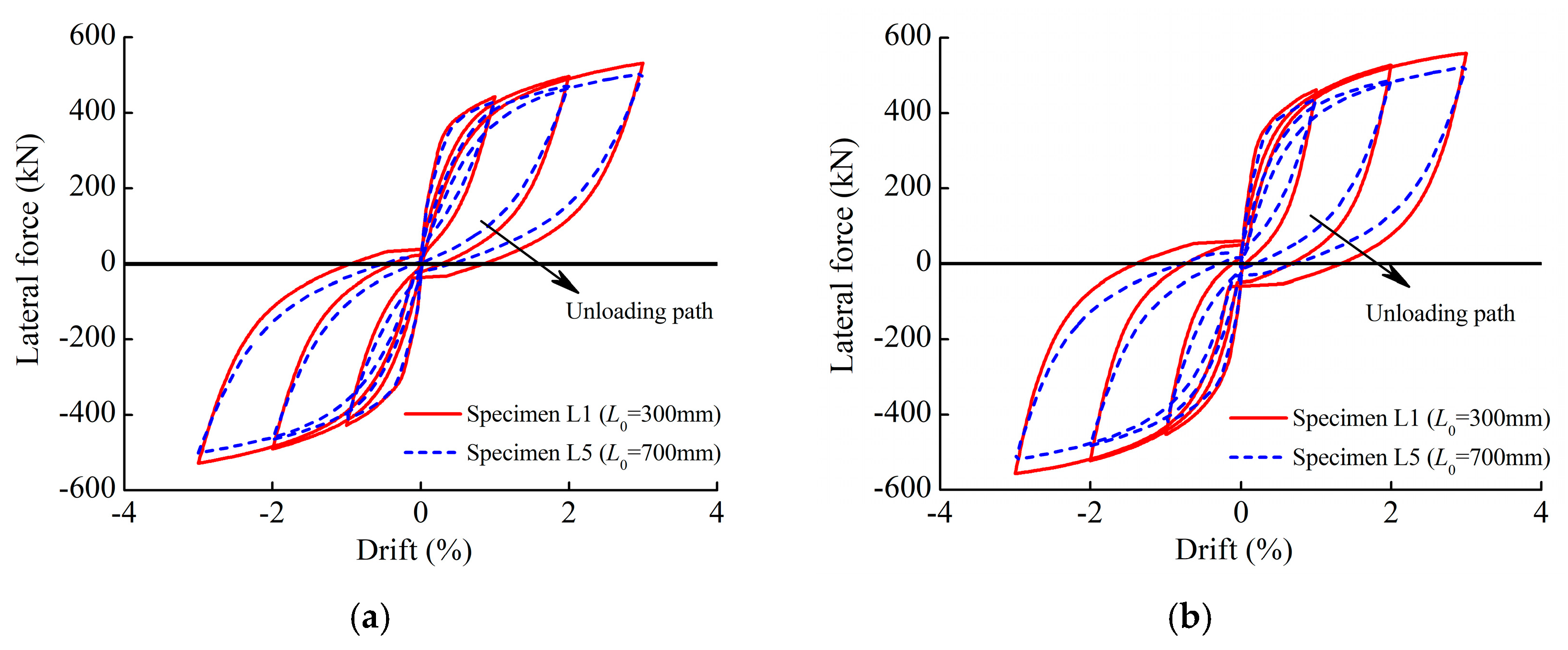
| Specimen | PT1 | HBD2 | HBD1 | s-SCP(I-ED) |
|---|---|---|---|---|
| Geometry | 350 × 350 mm2 | 350 × 350 mm2 | 350 × 350 mm2 | 400 × 400 mm2 |
| Aspect ratio | 4.57 | 4.57 | 4.57 | 3.78 |
| Total axial load | 200 kN | 300 kN | 200 kN | 533.05 kN |
| Tendons | 2 × 99 mm2 | 4 × 99 mm2 | 2 × 99 mm2 | 4Φ15.2 |
| 100 kN each | 75 kN each | 100 kN each | 313.05 kN total | |
| Dissipation | None | 4-HD20 | 4-D16 | 4-D20 |
| 12.5 mm diameter fuse | Reinforcing steel | Reinforcing steel | ||
| 50 mm fuse length | L0 = 50 mm | L0 = 100 mm | ||
| fy = 586 MPa | fy = 304 MPa | fy = 349 MPa |
| Specimen | Width/mm | λ | fc/MPa | ED Bar | ρED/% | fy/MPa | L0/mm | PT Tendon | ρPT/% | PG/kN | ηG | PPT/kN | ηPT |
|---|---|---|---|---|---|---|---|---|---|---|---|---|---|
| HBD1 | 350 | 4.57 | 54.1 | 4D16 | 0.66 | 304 | 50 | 2 × 99 mm2 | 0.16 | 0 | 0 | 200 | 0.03 |
| RS | 1050 | 4.57 | 54.1 | 20D22 | 0.69 | 304 | 300 | 12D15.2 | 0.2 | 1800 | 0.03 | 600 | 0.01 |
| Level | λ | fc | Pd | ρPT | ηG | L0 (mm) | fy (MPa) | ρED |
|---|---|---|---|---|---|---|---|---|
| (A) | (B) | (C) | (D) | (E) | (F = ABC) | (G = ABD) | (H = BCDE) | |
| Range | 4.42~5.29 | 32~65.9 | 0.12~0.51 | 0.13~0.65% | 0~0.1 | 50~400 | 300~600 | 0.26~1.03% |
| − (low) | 3.5 | 30 | 0.2 | 0.20% | 0.02 | 150 | 300 | 0.46% |
| + (high) | 6 | 60 | 0.4 | 0.60% | 0.1 | 450 | 600 | 1.12% |
| Case (Level) | Basic Design | Generated from Basic Design | ||||||
|---|---|---|---|---|---|---|---|---|
| λ | fc | Pd | ρPT | ηG | L0 | fy | ρED | |
| (A) | (B) | (C) | (D) | (E) | (F = ABC) | (G = ABD) | (H = BCDE) | |
| 1 | −1 | −1 | −1 | −1 | −1 | −1 | −1 | 1 |
| 2 | 1 | −1 | −1 | −1 | −1 | 1 | 1 | 1 |
| 3 | −1 | 1 | −1 | −1 | −1 | 1 | 1 | −1 |
| 4 | 1 | 1 | −1 | −1 | −1 | −1 | −1 | −1 |
| 5 | −1 | −1 | 1 | −1 | −1 | 1 | −1 | −1 |
| 6 | 1 | −1 | 1 | −1 | −1 | −1 | 1 | −1 |
| 7 | −1 | 1 | 1 | −1 | −1 | −1 | 1 | 1 |
| 8 | 1 | 1 | 1 | −1 | −1 | 1 | −1 | 1 |
| 9 | −1 | −1 | −1 | 1 | −1 | −1 | 1 | −1 |
| 10 | 1 | −1 | −1 | 1 | −1 | 1 | −1 | −1 |
| 11 | −1 | 1 | −1 | 1 | −1 | 1 | −1 | 1 |
| 12 | 1 | 1 | −1 | 1 | −1 | −1 | 1 | 1 |
| 13 | −1 | −1 | 1 | 1 | −1 | 1 | 1 | 1 |
| 14 | 1 | −1 | 1 | 1 | −1 | −1 | −1 | 1 |
| 15 | −1 | 1 | 1 | 1 | −1 | −1 | −1 | −1 |
| 17 | −1 | −1 | −1 | −1 | 1 | −1 | −1 | −1 |
| 18 | 1 | −1 | −1 | −1 | 1 | 1 | 1 | −1 |
| 19 | −1 | 1 | −1 | −1 | 1 | 1 | 1 | 1 |
| 20 | 1 | 1 | −1 | −1 | 1 | −1 | −1 | 1 |
| 21 | −1 | −1 | 1 | −1 | 1 | 1 | −1 | 1 |
| 22 | 1 | −1 | 1 | −1 | 1 | −1 | 1 | 1 |
| 23 | −1 | 1 | 1 | −1 | 1 | −1 | 1 | −1 |
| 24 | 1 | 1 | 1 | −1 | 1 | 1 | −1 | −1 |
| 25 | −1 | −1 | −1 | 1 | 1 | −1 | 1 | 1 |
| 26 | 1 | −1 | −1 | 1 | 1 | 1 | −1 | 1 |
| 27 | −1 | 1 | −1 | 1 | 1 | 1 | −1 | −1 |
| 28 | 1 | 1 | −1 | 1 | 1 | −1 | 1 | −1 |
| 29 | −1 | −1 | 1 | 1 | 1 | 1 | 1 | −1 |
| 30 | 1 | −1 | 1 | 1 | 1 | −1 | −1 | −1 |
| 31 | −1 | 1 | 1 | 1 | 1 | −1 | −1 | 1 |
| 32 | 1 | 1 | 1 | 1 | 1 | 1 | 1 | 1 |
| Displacement | Coefficients | ||||||
|---|---|---|---|---|---|---|---|
| a0 | a1 | a2 | a3 | a4 | a5 | a6 | |
| 2% | 0.760 | −0.062 | −0.060 | −0.106 | −0.154 | 0.148 | 0.179 |
| 3% | 0.749 | −0.062 | −0.062 | −0.115 | −0.161 | 0.130 | 0.173 |
| 4% | 0.746 | −0.063 | −0.061 | −0.118 | −0.157 | 0.119 | 0.173 |
| Parameters | Denotation | Parameter Values for Each Specimen |
|---|---|---|
| λ | A1, A2, A3, A4, A5 (A1–A5) | 3.6, 4.6, 5.5, 6.5, 7.4 |
| Pd | PD1, PD2, PD3, PD4, PD5, PD6 (PD1–PD6) | 0.15, 0.2, 0.3, 0.4, 0.5, 0.6 |
| PT1, PT2, PT3, PT4, PT5, PT6 (PT1–PT6) | 0.13%, 0.2%, 0.26%, 0.33%, 0.4%, 0.53% | |
| G1, G2, G3, G4, G5 (G1–G5) | 0.03, 0.045, 0.06, 0.075, 0.091 | |
| L0 | L1, L2, L3, L4, L5 (L1–L5) | 300 mm, 400 mm, 500 mm, 600 mm, 700 mm |
| fy | F1, F2, F3, F4, F5 (F1–F5) | 304 MPa, 350 MPa, 400 MPa, 450 MPa, 500 MPa |
| E1, E2, E3, E4, E5, E6 (E1–E6) | 0.46%, 0.69%, 0.89%, 1.12%, 1.46%, 2.28% |
| Specimens | Displacement | SC Factor | ED Parameter | Residual Displacement (%) | ||
|---|---|---|---|---|---|---|
| Test | Upper Limit | Predictive Result | ||||
| HBD1 | 2% | 1 | 0.98 | 0.94 | 1 | 0.54 |
| 3% | 0.98 | 0.97 | 1.55 | 1.53 | 1.04 | |
| HBD2 | 2% | 1.4 | 0.83 | 0.23 | 0.6 | 0 |
Disclaimer/Publisher’s Note: The statements, opinions and data contained in all publications are solely those of the individual author(s) and contributor(s) and not of MDPI and/or the editor(s). MDPI and/or the editor(s) disclaim responsibility for any injury to people or property resulting from any ideas, methods, instructions or products referred to in the content. |
© 2025 by the authors. Licensee MDPI, Basel, Switzerland. This article is an open access article distributed under the terms and conditions of the Creative Commons Attribution (CC BY) license (https://creativecommons.org/licenses/by/4.0/).
Share and Cite
Qin, H.; Fang, J.; Zhong, Z.; Ding, Y.; Shi, Y. Numerical Investigation and Factorial Analysis of Residual Displacement in Rocking Self-Centering Bridge Columns Under Cyclic Loading. Buildings 2025, 15, 1220. https://doi.org/10.3390/buildings15081220
Qin H, Fang J, Zhong Z, Ding Y, Shi Y. Numerical Investigation and Factorial Analysis of Residual Displacement in Rocking Self-Centering Bridge Columns Under Cyclic Loading. Buildings. 2025; 15(8):1220. https://doi.org/10.3390/buildings15081220
Chicago/Turabian StyleQin, Hongguo, Jinfeng Fang, Zhengwu Zhong, Yu Ding, and Yan Shi. 2025. "Numerical Investigation and Factorial Analysis of Residual Displacement in Rocking Self-Centering Bridge Columns Under Cyclic Loading" Buildings 15, no. 8: 1220. https://doi.org/10.3390/buildings15081220
APA StyleQin, H., Fang, J., Zhong, Z., Ding, Y., & Shi, Y. (2025). Numerical Investigation and Factorial Analysis of Residual Displacement in Rocking Self-Centering Bridge Columns Under Cyclic Loading. Buildings, 15(8), 1220. https://doi.org/10.3390/buildings15081220





